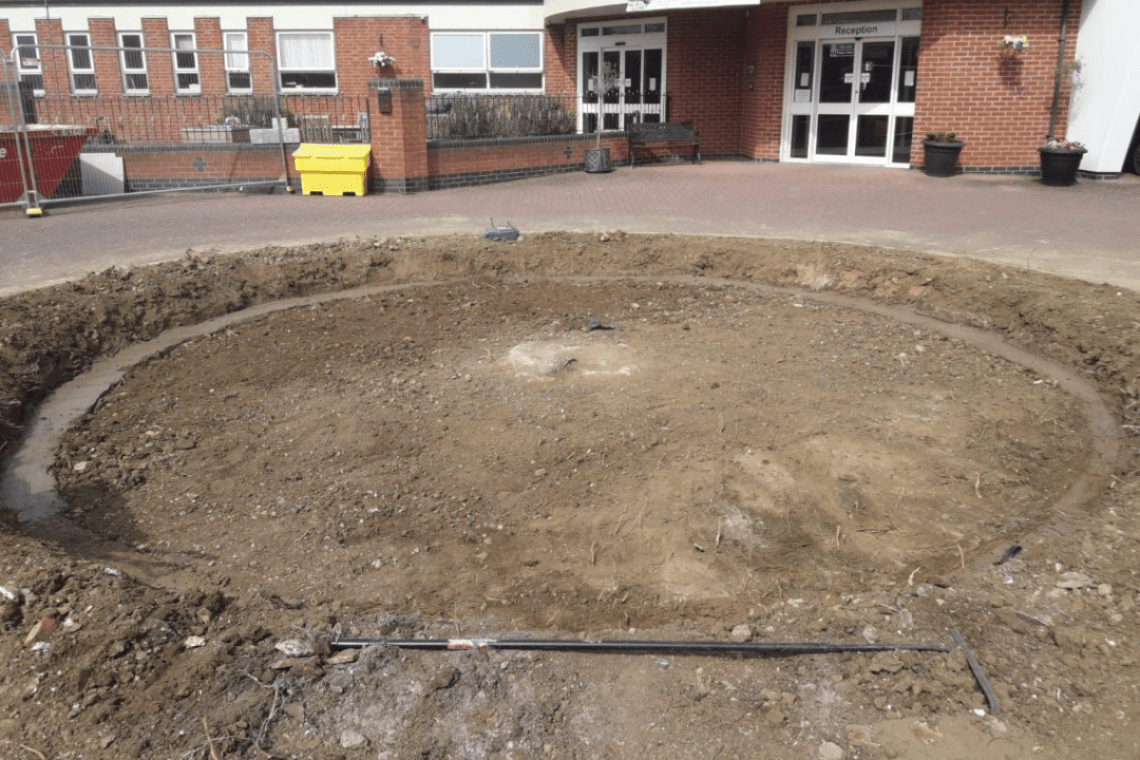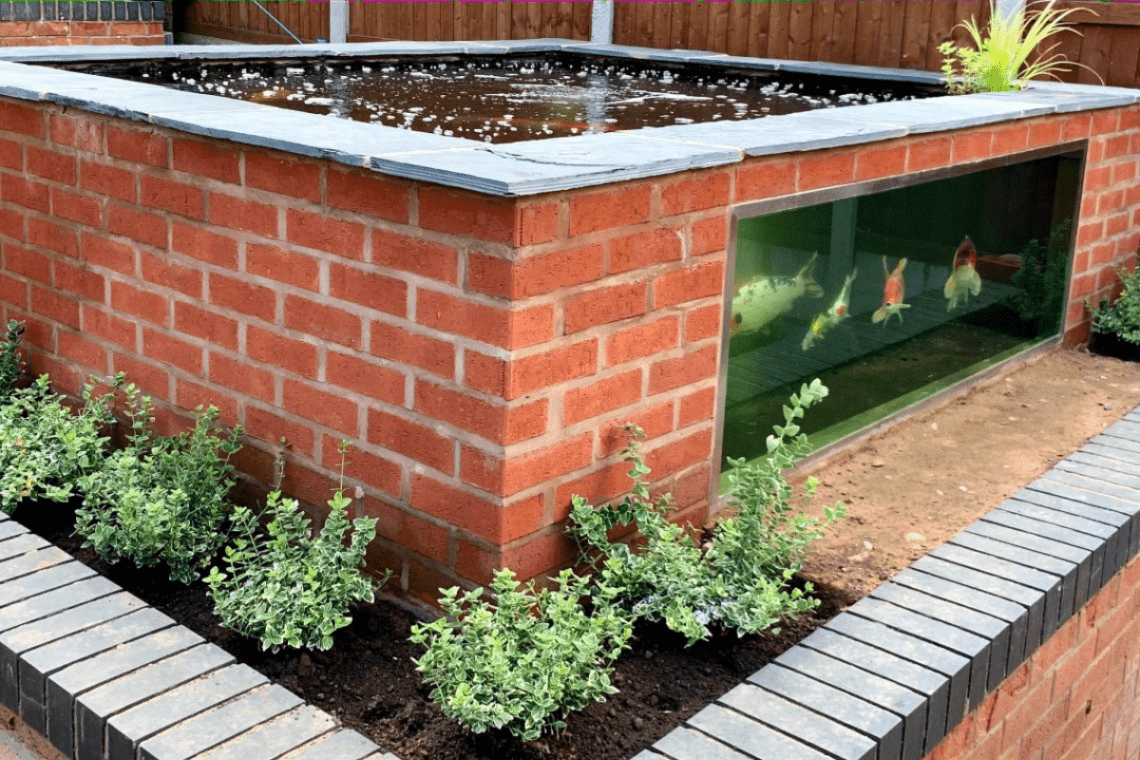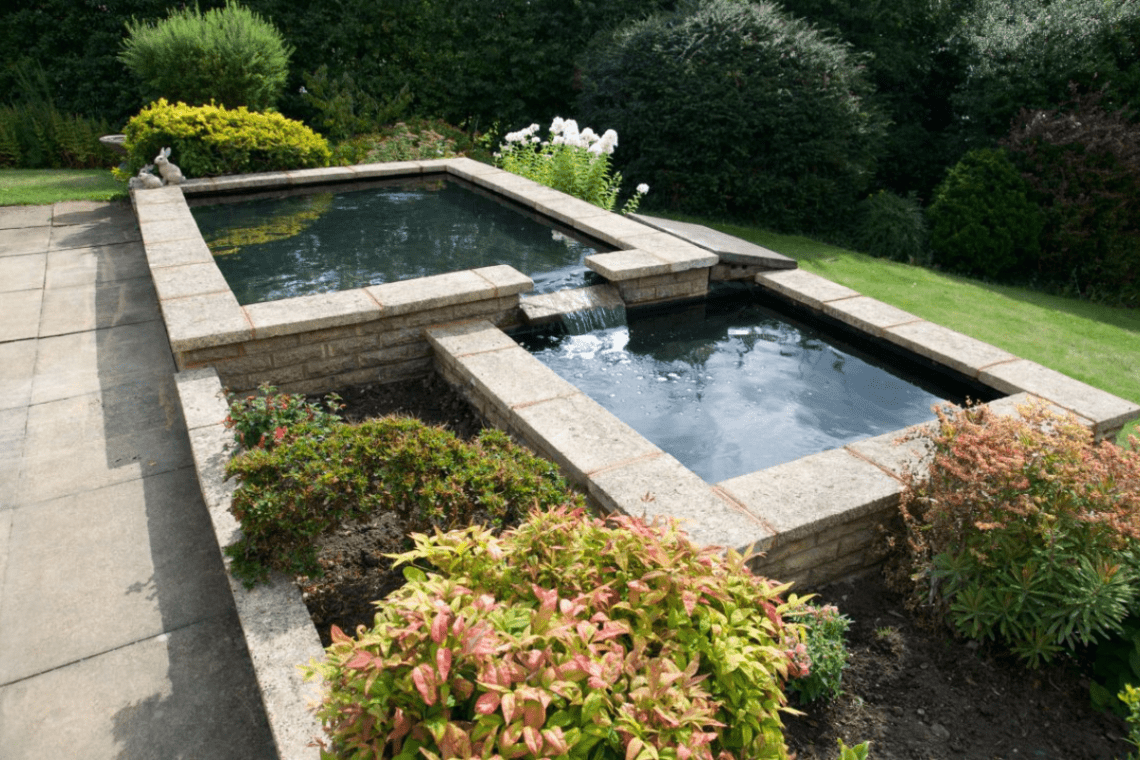A raised pond transforms a garden fast. It invites wildlife, softens noise, and brings a calm, reflective feel to any outdoor space.
At Ponds by Michael Wheat, we design and build raised ponds that look stunning and run smoothly year-round. Use this step-by-step guide to learn how to build a raised pond—or hand it to our team and we’ll deliver the lot.
Planning Your Raised Pond

A pond is a great way to enhance your living environment and requires planning for it to blend seamlessly in your garden or outdoor space.
Choose Your Core Materials
A pond can lift your whole outdoor space, and a little planning ensures it blends seamlessly with your garden while working exactly as intended.
- Core materials: Choose timber, concrete blocks, or brick, then define the size and shape.
- Design features: Consider a pond window and durable materials to strengthen the structure and elevate visual appeal.
- Budget & style options: Railway sleepers offer a rustic look; concrete blocks deliver strength.
- Site selection: Always build on a level surface for stability and a professional finish.
- Shape choice: Decide on a square or rectangular shape. Sleepers commonly come in L-shaped 6″×3″, allowing a 6″×6″ pond.
- Size considerations: Smaller ponds may need specific equipment and fish species suited to compact environments.
Materials and Tools Needed to Build a Raised Pond
Your toolkit depends on your build choice—raised timber pond, concrete blocks, or brick—so plan your shopping list around the method you’ll use. Timber frames call for accurate measuring and neat finishing; masonry builds benefit from rock-solid levels and careful alignment.
At a minimum, gather pond liners to keep everything watertight and pond equipment to keep water healthy—think pumps, filters, UV clarifiers, and other essential components, including a dedicated water filter and pump for reliable circulation and clarity.
Add a tape measure for precise dimensions and a spirit level to keep courses true. A sturdy shovel handles site prep, levelling, and any small adjustments before you set the frame.
Prefer an engineered, low-maintenance setup? Discover the Michael Wheat System—our proven, high-clarity ecosystem that pairs the right liner, pump, and filtration for long-term performance.
4 Steps for How to Build a Raised Pond

Determining where to start when figuring out how to build a raised pond can be daunting. Here are step-by-step instructions to build a perfect pond.
1. Choose a location for your pond
You should consider the placement of your pond before building it. Ideally, your pond should be in an area where it is visible and accessible. For example, a good place to put your pond would be within an outdoor seating area, like a patio or cabana in your garden.
Also keep in mind that it should be close to a power point for the filtration system, or if this is not an option, then decide how you will bring power to the area where you are planning to install the pond.
2. Ensure the ground is level
Your garden pond installation should be in a location where the ground is even to ensure the water does not overflow on one end or side. It should also be protected from sharp objects that can potentially puncture the lining and compromise its watertight nature, including stones, tree roots, or any other hazardous items.
To check if the ground is even, you can put a piece of wood on the area and place your spirit level on top. If it is not flat, you can even out the surface with a shovel, but this is the most digging you’ll have to do, which is a lot less labour intensive than compared to building an in-ground pond.
3. Build the pond frame
A solid pond structure is the backbone of your raised pond. Lay out your railway sleepers or timber in the chosen shape and get the first course perfectly level—this sets the standard for everything above. Keep sleepers flat and tight, fix corners with two screws, and use sturdy angle brackets to lock in accurate 90° corners. Build up layer by layer until the second-to-last course, checking alignment and level each time for a straight, stable stack.
Before lining, inspect for any sharp edges or exposed fixings. Add an underlay for protection, then drape the liner with a slight overlap. Fill slowly, trim and secure the liner for a clean, watertight edge, and finish with the final sleeper layer to clamp it in place.
Consider timber capping for a polished look. Prefer a lighter approach? You can frame with cut timber or decking strips and support with matching-height corner posts to resist water pressure.
- Level the first course and confirm true 90° corners
- Check that the frame is structurally sound
- Tight joints, corners fixed with two screws, brackets for stability
- Re-check level after every course; stagger joints where possible
- Place the pond underlay beneath the liner; keep a small overlap to prevent leaks
- Trim any excess liner around the outer edges; add capping for a furniture-grade finish
- For the alternative method: pre-drill, use exterior fixings, brace posts
4. Fill the pond with water
This is the best step because you get to witness your pond come to life. Ensure that the water level does not reach past the point of the final layer of your sleepers or your timber capping where the liner overlaps when you fill it with water.
Finishing Touches and Maintaining a Raised Pond

Garden ponds and fish ponds are very popular at the moment. You can add fish or plants to your pond to give it more life. However, ensure that the species of fish and/or plants are compatible with each other so that they are able to thrive.
Planting for Wildlife & Garden Ponds
For a garden pond or wildlife pond, you should add 6–8 inches of low-nutrient clay soil at the surface of the pond to make it easier for your plants to grow. Ensure that the tall plants are planted at the back of the pond and the shorter plants in the front. When planting aquatic plants, use proper planting techniques and select suitable species for different depths to support a healthy ecosystem and attract a variety of wildlife.
Filtration for Fish & Koi Ponds
For fish ponds or a koi pond, you should install a water filtration system to ensure that the water quality is optimal for a healthy living environment that they can thrive in.
The pond filter and pump will also ensure that all the fish waste is taken care of, so ensure you purchase the correct pump type depending on the size and depth of your pond.
Consider adding a UV clarifier to help control algae and improve water clarity, and make sure the pump’s flow rate matches your pond’s capacity for effective filtration and circulation.
Simple Maintenance Routine
You should check the water quality and filters from time to time to ensure that the fish are well taken care of. Regular pond maintenance, such as cleaning filters and inspecting equipment, is essential for keeping your pond healthy.
Final Thoughts

A raised pond is a practical and stylish addition to any garden, offering a unique way to enhance your outdoor space. With the right approach and a good-quality pond liner, you can create a beautiful and functional feature.
For professional help, trust Ponds by Michael Wheat to bring your vision to life with our expert craftsmanship. And to keep your pond in top condition (and save yourself some hassle!), check out our Pond Maintenance Packages.
Contact us now to start building the perfect raised pond that you’ll enjoy for years to come!
FAQ for Building a Raised Pond
Can I build a raised pond on my type of land?
If you own your home, your property is considered “permitted development” and does not require planning permission. However, you may need to obtain planning permission to build a pond where it is visible from the road or if you live in a listed property, conservation area or AONB.
How long does it take to build a raised pond?
The timeframe for raised pond building is dependent on size, purpose, access, and landscaping. Ponds by Michael Wheat have installed projects within 2-3 days and also up to 3 weeks.
What are the best plants for a raised pond?
If you are opting for a raised garden pond, floating plants and marginal plants are fairly popular for small garden ponds. Deep marginal plants are an option if your pond has more depth. Consider the size of your pond and its position to the sun before you make your choice.
Pond plants that would complement the rest of your garden well are:
- Water lilies
- Water mint
- Water forget-me-not
- Fanwort
- Waterweed – Elodea